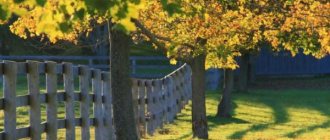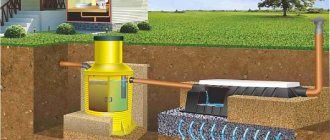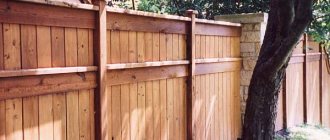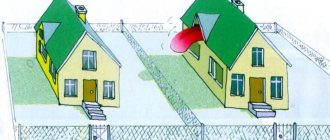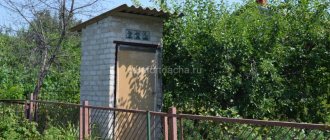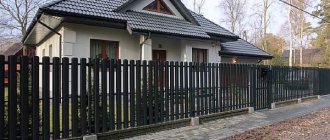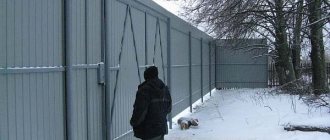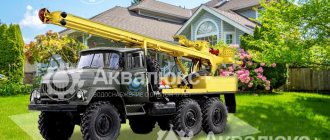Any gardener can plant various plants on his plot, but only according to the rules. Placing green spaces in SNT and individual housing construction requires knowledge that the distance from the tree to the fence with the neighbor, according to the law, SNiP, SP and SanPiN standards, should be from 1 to 4 meters. The rules take into account that during growth, the crown can cast a shadow and the roots can harm communications. As a result, by maintaining a normal distance from the fence to trees or bushes, conflicts can be avoided.
Beautiful landscape
Other restrictions and requirements for tree planting
The minimum distance between a neighbor's fence and one of the large tree species is at least four meters. These crops include:
- various varieties of pears;
- apple trees;
- Oak trees;
- maple;
- coniferous species (including pine, spruce, cypress).
As for medium-sized trees, less stringent restrictions will apply. The distance between such varieties and the fencing of the neighboring plot should be no more than 2 meters. Such trees include:
- cherry;
- plum;
- sea buckthorn
- hazel
Often these crops do not exceed 10 meters in height, so they are considered safe for the neighboring area.
It happens that dwarf plant varieties are also planted in dacha areas. Traditionally, their height is 2-2.5 meters. For such crops, the minimum distance from bushes and the neighboring fence is only 1 meter. Plants of this type include:
- honeysuckle;
- bush raspberries;
- blackberries;
- black currant.
It is necessary to comply with planting standards, since this point is prescribed in the law. By violating it, you create a conflict, which entails a fine in an amount corresponding to the severity of the violation (the type of problems that were caused for non-compliance with SanPin standards).
A tree with a large root system will damage the hedge. Example of incorrect landing Source samstroy.com
Subtleties in the rules for septic tank location
You can start digging a hole and installing a septic tank after permission has been received. By law, a minimum distance is maintained to all sources of water, your own and your neighbors. The rules for the location of the septic tank must be strictly observed.
Construction at the dacha
When receiving permission to develop a site, the architecture department and sanitary supervisory authorities check the layout of the house and utility rooms on all adjacent plots.
They double-check the availability of water sources. If the minimum setback from the required points is observed, a building permit is issued.
If there is nothing nearby or construction behind the fence has not begun, or more precisely, permission has not yet been issued, you can maintain a distance in compliance with sanitary standards only from your house and well. It is enough to retreat 1 m from the side border of the site, the fence.
The garage belongs to the category of ancillary buildings. Sanitary standards allow the installation of a septic tank at a distance of 1 m from it. Unlike sheds, a permanent strip foundation is made for the garage. If there is an inspection pit, experts recommend retreating at least 2 m so that wastewater does not wash away the base of the building and penetrate into the pit and basement.
Is it possible to make a smaller indentation from the fence and, in agreement with the neighbor, symmetrically place sedimentation tanks at a distance of 1 m on both sides of the fence? A building permit will have to be issued at the same time. Both owners of the site indicate in a statement of joint agreement and their consent to such deviations from the norms.
Read: Safe distance from power lines to a residential building: minimum permissible standards SanPiN 2021
Types of discomfort that improperly planted houses can cause
Planted trees should bring joy to you, as the owner of the local area, but not cause discomfort to your neighbor. The problem may appear in a number of cases:
- the crown of the tree obscures light-loving crops in the neighboring area (thereby affecting the yield of a particular crop);
- the branches of your plant may litter the neighboring area with falling leaves;
- the greater power of the root system prevents neighboring plants from feeding and bearing fruit normally.
If such problems regularly arise, the neighbor has the right to independently cut off the interfering branches (even if there are fruits on them) or contact the administration (village council) to resolve the issue through legislative regulation.
What other restrictions are being considered?
SNiP, which regulates all standards regarding tree planting, has been registered since 1997 and today does not change its standards. Therefore, when planting, be sure to take into account the specifics of their growth.
How to correctly position the plant on the site in relation to the fence Source snt-veteran.rf
Accordingly, the standards must be taken into account not only regarding the distance to the neighboring fence, but also regarding other objects. Thus, it is worth paying attention to the following few points:
- the distance from large tree trunks to the fence is 4 meters;
- distance from poultry houses and outbuildings - 4 meters;
- distance from residential buildings - 3 meters;
- distance from trunks of medium-sized trees - 2 meters;
- distance from bushes - 1 meter.
The area of the current garden plots does not allow for wandering, so every centimeter has to be taken into account and the territory used sparingly. At the same time, it is impossible to plant trees randomly; this threatens a conflict in which plant crops will not be able to produce a good harvest.
On a note! If you plant tall trees on a site near houses, they can disrupt the functioning of communications: water supply and sewerage are deformed under the influence of the root system, and electricity due to contact with branches (threatens a short circuit).
Legislative regulation of the issue
There is a widespread belief among people that on a privately owned plot of land they can do and build whatever and however they want, as long as it does not contradict the current legislation of the state. In practice this is not the case.
The owner of the territory can indeed build whatever he wants on his site, if the object being built does not violate legal norms and does not contradict the type of permitted use of the site. However, he can only do this in compliance with building codes and regulations. This even applies to landscaping by planting trees. They must be located at a certain distance from other objects on the site, as well as from its boundaries.
The regulation of the minimum distance of trees at which they must be located from other objects is prescribed at the legislative level. It is indicated in the contents of the building rules and regulations:
- SNiP 30-02-97 dated January 1, 1998;
- SNiP 30-102-99 dated January 1, 2000.
Selecting the distance from green spaces to the road
This parameter is no less important and is also indicated in sanitary standards. For each landscaping object, the distance will be different, since it all depends on the height of the plant. For example, from a strip of shrub species to the road there should be 1.5 meters. If all these breeds are tall, then the distance should be at least 3 meters.
Norms for planting placement according to SNIP Source stroychik.ru
Generalized table
To plan your plantings, you can refer to the table reflecting current legislation.
| An object | Distance (m) | |
| To the trees | For shrubs | |
| External walls of buildings | 5 | 1.5 |
| Retaining wall foundations | 3 | 1 |
| Ditches and ditches | 2 | 1 |
| Sidewalks | 0,7-1,5 | 0,5-0,7 |
| Fences and barriers | 4, and in SNT - 3 | 1 |
| Highway | 2 | 1 |
| Power lines | 1,5-2 | — |
| Gas network, sewerage | 1.5 | — |
| Water supply network, heating network | 2 | 1 |
| Power and communication cable | 2 | 0,7 |
Dispute Resolution: Details
As a rule, all issues, including the responsibility for growing green spaces on the territory of the local area, rest solely with the owner of the house. Therefore, everything related to violations and compensation for damage will directly affect the owner of the land.
The Land Code regulates the use of common land between two plots. More precisely, it states at what specific distance plantings are allowed between two adjacent plots (belonging to residential or gardening).
In case of violations, disputes often arise among neighbors about whose fruits are from the trees whose branches hang on the grid of the neighboring plot. As it turned out, if the problem cannot be resolved peacefully, then your neighbor can pick the fruits from your tree without your permission. Moreover, you will not be able to present anything, since you yourself are violating the requirements and standards regarding the distance of plantings in relation to someone else’s fence.
On a note! The court may make a decision in which, according to the law, the fruits from the tree that interferes with the neighbor are divided by gender. In case the plant is planted on the border between two plots, then the opposite owner has the right to demand that the plant be replanted.
Please note that if a tree from a neighboring plot hangs over the fence and interferes with the plants with its crown, then the owner of the adjacent territory has the right to cut off the branches or cut down the root system only if such circumstances caused damage to the crops growing on his plot: the fence was damaged, deformed outbuildings.
Otherwise, removing tree branches is prohibited. You will have to talk to the owner of the plant first if you are planning to plant seedlings or your own low-growing fruit crops in this place.
Distance from tree to fence Source zaborsebe.ru
Important to consider
In case disputes arise between neighbors regarding planted trees, shrubs and other vegetation, it is necessary to contact the local government in writing. It must indicate in detail the essence of the problem, be sure to include a date and signature.
The review will take several days (up to 10 days). After this, the authorities are obliged to go to the site and help the neighbors sort out the issues of the incorrectly planted plant. Please note that three days after the application, both parties to the conflict must receive a response in writing about the decision made. Also, each neighbor should be informed about the day the authorities will go to the site to solve the problem, and wait.
The outcome of the decision can be positive or negative. If the parties do not agree with the decision made, they have the right to go to court to re-decide the issue. Please note that local authorities have the right to ask to cut down a tree or dig up interfering bushes.
Distance between green spaces and communications: gas pipeline, water supply
This issue should not be ignored. After all, developing trees and other plantings can disrupt the integrity of the structure. These objects also have their own regulatory rules.
- If there is an underground gas pipeline or water supply on the site, then the distance from the tree should be at least 3 meters. This is due to the fact that during the development of the root system, integrity damage, water breakthrough or gas leakage are possible.
- In the case of ground communications, the following norm is adhered to: the distance should be equal to the height of the plants. That is, if you plant a tree that can reach a height of three meters, then the pipeline should be 3 meters from it.
Also, the listed rules apply to the sewerage system, septic tanks and common hatches located on the territory of a summer cottage or adjacent plot.
Septic tank options
When planning to create a sewer system in a house, it is necessary to immediately design a local treatment system. It is important to position the septic tank correctly so that all standards are met and met. It is necessary to calculate the volume of wastewater and select the appropriate VOC design.
Layout at the dacha
For a summer house with temporary accommodation for up to 4 people and a shower in the bathroom, a single-chamber sump tank with a bulk bottom is suitable. Filtration will be carried out through it and some of the water will come out. It will be enough to pump out the contents from it once a season.
On soils with groundwater close to the surface, a tank with a solid bottom or concrete rings stacked on top of each other with a cushion at the bottom will be optimal. Under them you need to dig a hole 4 m deep with a layer of clay below. You will have to pump out water from such a waste collector more often, once every 3–5 months, but there will be a guarantee that the water in the well will not become contaminated.
For a house with a bathroom and several sinks, a kitchen sink and other equipment, a model with an overflow and biological water purification or disposal through an aeration field is required. The water at the output of such a device can be used as technical water: to water the garden, wash the car, paths and the facade of the house. Maintenance frequency – sludge cleaning 1–2 times a year.
The common village latrine and cesspool belong to another category of disposal devices. The distance to it from the fence according to SNIP (SP) is much greater.
Read: Who should make and install a fence between neighbors in a private house and on a summer cottage
Reviews of conflict situations regarding green spaces
To make the situation clear, we suggest that you read reviews from real people who have encountered similar problems.
Marina, 46 years old, Voronezh
They say that ignorance of the law does not exempt you from responsibility. Unknowingly, I planted a tree right next to the neighbor’s fence. When the plant grew, it began to tear apart the fence mesh. The neighbor went to court without waiting for a decision from local authorities, without asking me. I won the case and a fine was collected from me.
Mikhail, 54 years old, Shchelkino
All our lives we lived amicably with our neighbors until they planted fruit trees right next to the fence - 40-50 cm from it. On my side of the plot there were strawberries growing, which began to die due to lack of sunlight. Local authorities forced neighbors to compensate for the damage and replant fruit crops.
Valentina, 49 years old, Pushkino
I bought a plot of land in a holiday village and planted trees, not knowing that there was a water supply running underground. 7 years later, the apricot roots violated its integrity, and there was a breakthrough. After that, I was forced to pay a fine and repair communications at my own expense.
